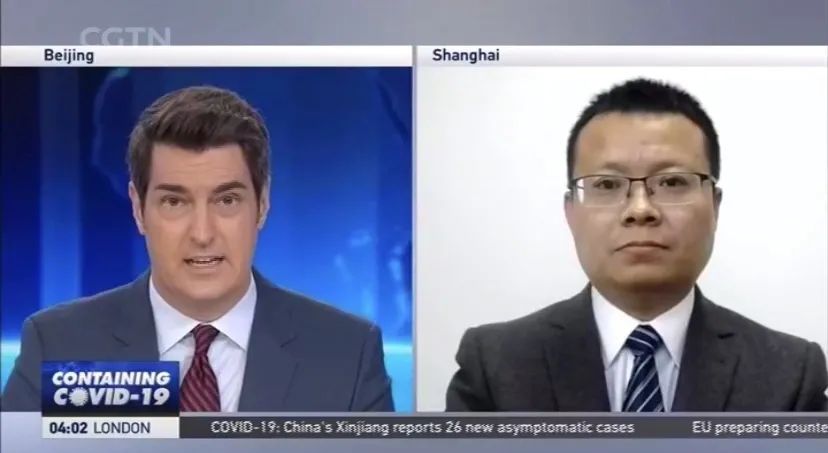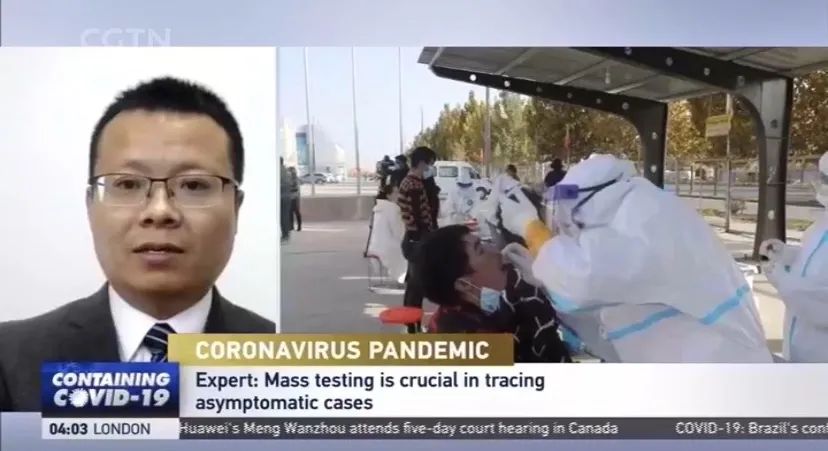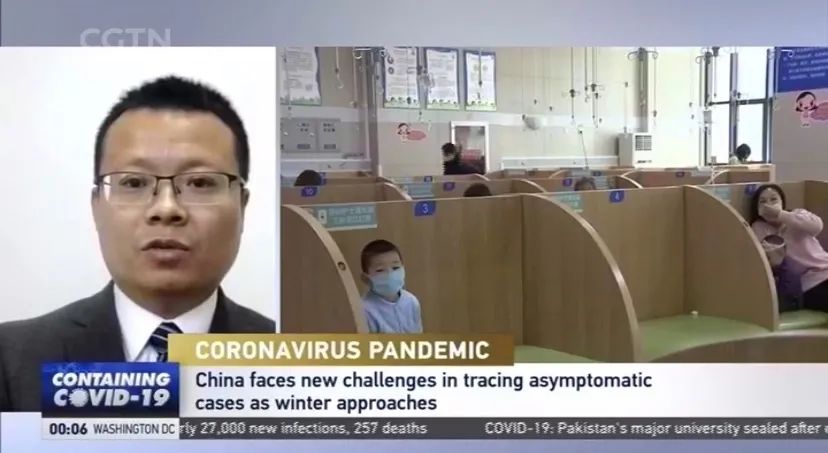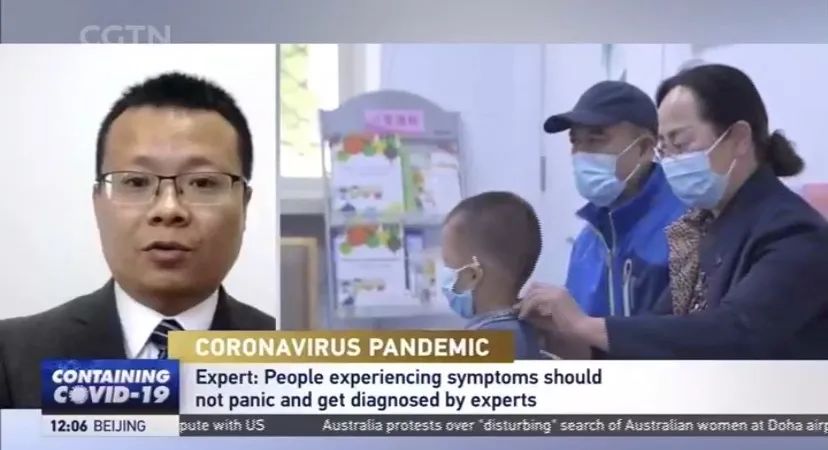上海交大赵大海关于新冠疫情第58次在电视台访谈评论:秋冬季节给新冠防控带来压力,但中国不可能出现新冠第二波大流行
上海交通大学国际与公共事务学院博士生导师、上海交通大学-耶鲁大学卫生政策联合研究中心执行主任赵大海,自新冠肺炎疫情暴发以来,对于新冠疫情暴发、防控以及医疗卫生体制改革第36次接受中央电视台直播专访,也是第58次接受央视、上视专访。2020年10月27日,赵大海在中央电视台英语频道的《环球瞭望》节目,就中国最近新疆新冠疫情、秋冬季对新冠疫情的影响及政府和居民的新冠防控等话题进行了直播访谈。现将专访内容翻译并摘录如下。
主持人:在青岛和新疆最近都新发现了新冠肺炎病例。此外,这些新发现的病例大多数是无症状感染者。请问追踪无症状患者的挑战是什么?
赵大海:发现新冠肺炎无症状感染者的常见方法是在追踪一名确诊新冠肺炎患者的所有密切接触者之后,需要对于这些密切接触者采用核酸检测的方法来判断是否是新冠肺炎感染者。当密切接触者接受核酸检测时,有时会发现无症状感染者。此外,当没有症状的普通居民自愿接受核酸检测时,也可能会发现无症状感染者。因此,追踪新冠肺炎无症状患者的主要挑战是需要在没有症状的普通人群当中通过核酸检测的方法来寻找。此外,考虑到在普通人群当中发现新冠肺炎无症状感染者的概率是极为罕见的,因此,开展全人群的核酸检测的成本问题也是另一个挑战。
主持人:流行病学家警告说,新冠肺炎在秋季和冬季可能会激增。我们已经看到这种情况发生在了美国和欧洲。中国政府应该怎么做才能防止另一波的新冠暴发?
赵大海:据我所知,秋冬季节可能会增加新冠肺炎第二波大流行的风险。然而,中国与美国或欧洲国家的情况有巨大差异。我认为美国大流行仍然处于第一波大流行期间,美国在夏季的时候,疫情依然非常严重。另外,在夏季的时候,欧洲各国的新冠大流行并没有完全控制住。然而,在中国,近半年多以来,新冠疫情已得到控制。对于中国政府的防控措施而言,第一是继续采取严格的防控措施,防止新冠病毒的境外输入;第二是各级政府、卫生行政部门和医院需要进一步提高对新冠肺炎无症状感染者和疑似病例的早期监测能力;第三,各地政府应进一步提高应对未来潜在新冠局部暴发的应急防控能力。总之,我非常有信心地认为中国不可能出现新冠疫情的第二波大流行。
主持人:我们目前是处于流感易发季节,鉴于新冠肺炎和和流感的症状非常相似。对此,您对政府和出现这些症状的居民有什么建议?
赵大海:首先,全国人民不必恐慌。毕竟,新冠肺炎疫情在中国绝大部分地区已完全得到了控制。因此,当人们有类似症状出现之时,没有必要过于担心。其次,当人们出现新冠或流感类似症状时,应当尽快到正规医院去就诊以做专业鉴别。此外,为了应对秋冬季流感和新冠肺炎,人们在进入公共场所时应继续佩戴口罩,并养成预防流感和新冠肺炎的健康生活习惯。
供稿者:国务学院
日期:2020年10月27日
Dahai ZHAO’s 58th comments on TV during the pandemic: Although the infection during autumn and winter season risks, there is no possibility of the second wave of COVID-19 outbreak in China
Dahai Zhao, a doctoral supervisor at the School of International and Public Affairs of Shanghai Jiao Tong University and Executive Director of Shanghai Jiao Tong University-Yale University Joint Research Center for Health Policy, has been interviewed by CGTN for the 36nd time (the 58nd time by CGTN / ShanghaiTV) since the COVID-19 pandemic. On October 27, 2020, Zhao commented on the prevention and control of COVID-19 and medical and health system reform on “Global Watch” of CGTN.
Anchor: The recent cases found in Qingdao, Shandong and now Xinjiang are majority asymptomatic. What are the challenges in tracing asymptomatic patients?
ZHAO: The common method of finding asymptomatic cases is to trace all close contacts of a confirmed case of COVID-19. When the close contacts take the nucleic acid test, the asymptomatic cases will be found. In addition, when the common citizens who have no symptoms actively take the nucleic acid test, the asymptomatic cases will also be found. The major challenges in tracing asymptomatic patients is to carry out the nucleic acid test for common citizens who have no symptoms. Further, considering the incidence rate of asymptomatic cases among common population is rare. The cost of carrying out the city-wide screening is also another challenge.
Anchor: Epidemiologists have warned that COVID-19 cases could surge in fall and winter. We already see that happening in the US and Europe. What should the Chinese government do to prevent another wave?
ZHAO: As far as I know, the season in fall and winter may enhance the risk of COVID-19 pandemic. However, there is a big difference between China and US or European countries. Because the pandemic in the US is during the first wave of the pandemic, the pandemic in US in Summer is still very serious. the pandemic in the Europe has not been completely under control even in Summer. In China, the pandemic has been under control for about half a year. For Chinese government’s preventing measures. First, Chinese government should continue to carry out stringent measures to prevent the virus of COVID-19 coming into China through imported persons or goods, Second, all local governments, health departments and hospitals should further improve the monitoring capacity for the asymptomatic cases and suspected cases of COVID-19. Third, all local governments should further improve the response and preparation ability to address up the potential local outbreak of COVID-19. Once a local outbreak occurs, the local government needs to carry out more scientific and faster response measures to cope with the potential outbreak. In total, I am very confident that it is impossible for China to have a second wave of COVID-19 pandemic.
Anchor: We are in a flu season and the symptoms between COVID-19 and the flu are quite similar. What would be your advice to people who experience these symptoms?
ZHAO: First, it is not necessary for people in the whole China to be in the panic. After all, the situation of COVID-19 has been under control in the most majority of areas in China. Therefore, when people have similar symptoms, it is really not necessary for them to seriously worry about this. Second, when people have the similar symptoms, they should directly go to regular hospital and recognize the symptoms as soon as possible. In addition, people should continue to wear face mask when they go to public areas, and have a good health habit of preventing flu and COVID-19.
Contributor: SIPA, SJTU
Data: October 27, 2020

